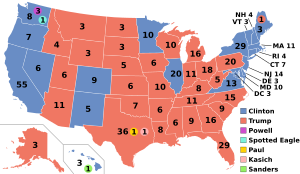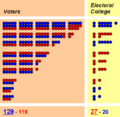U.S. Electoral College facts for kids
In the United States, most elections work simply: the person with the most votes wins. But for the President and Vice President, it's different. They are not chosen directly by citizens. Instead, they are elected by special people called "electors" through a system known as the Electoral College.

This system comes from the U.S. Constitution. The Founding Fathers of the United States created the Electoral College as a middle ground. They wanted a way to choose the president that was fair for both larger and smaller states. It was a compromise between letting Congress pick the president and letting only the popular vote decide.
Contents
Who Are Electors?
Each state gets a certain number of electors. This number is the same as how many members it has in Congress (both the House of Representatives and the Senate). For example, if a state has 10 members in the House and 2 Senators, it gets 12 electors.
Washington, D.C., also gets three electors, even though it's not a state. In total, there are 538 electors across the country.
Political parties in each state choose their own list of people who could become electors. How and when these electors are chosen can be different in each state.
How the Electoral College Works
When you vote for president, your vote goes into a statewide count. In 48 states and Washington, D.C., the candidate who wins the most votes in that state gets all of that state's electoral votes. This is called a "winner-take-all" system.
However, Maine and Nebraska do things a bit differently. They can split their electoral votes based on who wins in different parts of their state.
To win the presidential election, a candidate needs to get at least 270 electoral votes. This is more than half of the total 538 votes.
Usually, news channels announce a projected winner on election night in November. But the actual Electoral College vote happens later, in mid-December. That's when the electors meet in their own states to cast their official votes.
The Constitution doesn't force electors to vote for the candidate who won their state's popular vote. But it's very rare for an elector to vote differently.
Special Election Situations
When the Popular Vote Loses
Sometimes, a candidate can win the Electoral College but lose the overall popular vote (meaning fewer people across the country voted for them). This has happened a few times in U.S. history. For example, it occurred in the 2016 and 2000 elections. It also happened three times in the 1800s.
What if No One Wins Enough Votes?
If no candidate gets the majority of electoral votes (at least 270), then the decision goes to the House of Representatives. The House members then choose the new president from the top three candidates.
If this happens, the Senate would then choose the vice president from the remaining top two candidates.
This has only happened once in U.S. history. In 1824, the House of Representatives elected John Quincy Adams as president.
Changing the Electoral College
The Electoral College system is part of the U.S. Constitution. To change how it works, the country would need to pass a constitutional amendment. This is a very difficult process that requires a lot of agreement across the country.
Images for kids
-
Certificate for the electoral votes for Rutherford B. Hayes and William A. Wheeler for the State of Louisiana (1876).
-
This graphic shows how the winner of the popular vote can still lose in a hypothetical electoral college system.
-
A bar graph of popular votes in presidential elections (through 2012). Blue stars mark elections where the winner did not have the most popular votes. Black squares mark cases where the electoral vote was tied or the winner didn't have a majority. 'H' marks elections decided by the House, and 'S' marks one decided by the Supreme Court.
-
These maps show how much attention was given to each state by the Bush and Kerry campaigns during the final five weeks of the 2004 election. Waving hands show candidate visits, and dollar signs show money spent on TV ads.
See also
 In Spanish: Colegio Electoral de los Estados Unidos para niños
In Spanish: Colegio Electoral de los Estados Unidos para niños










